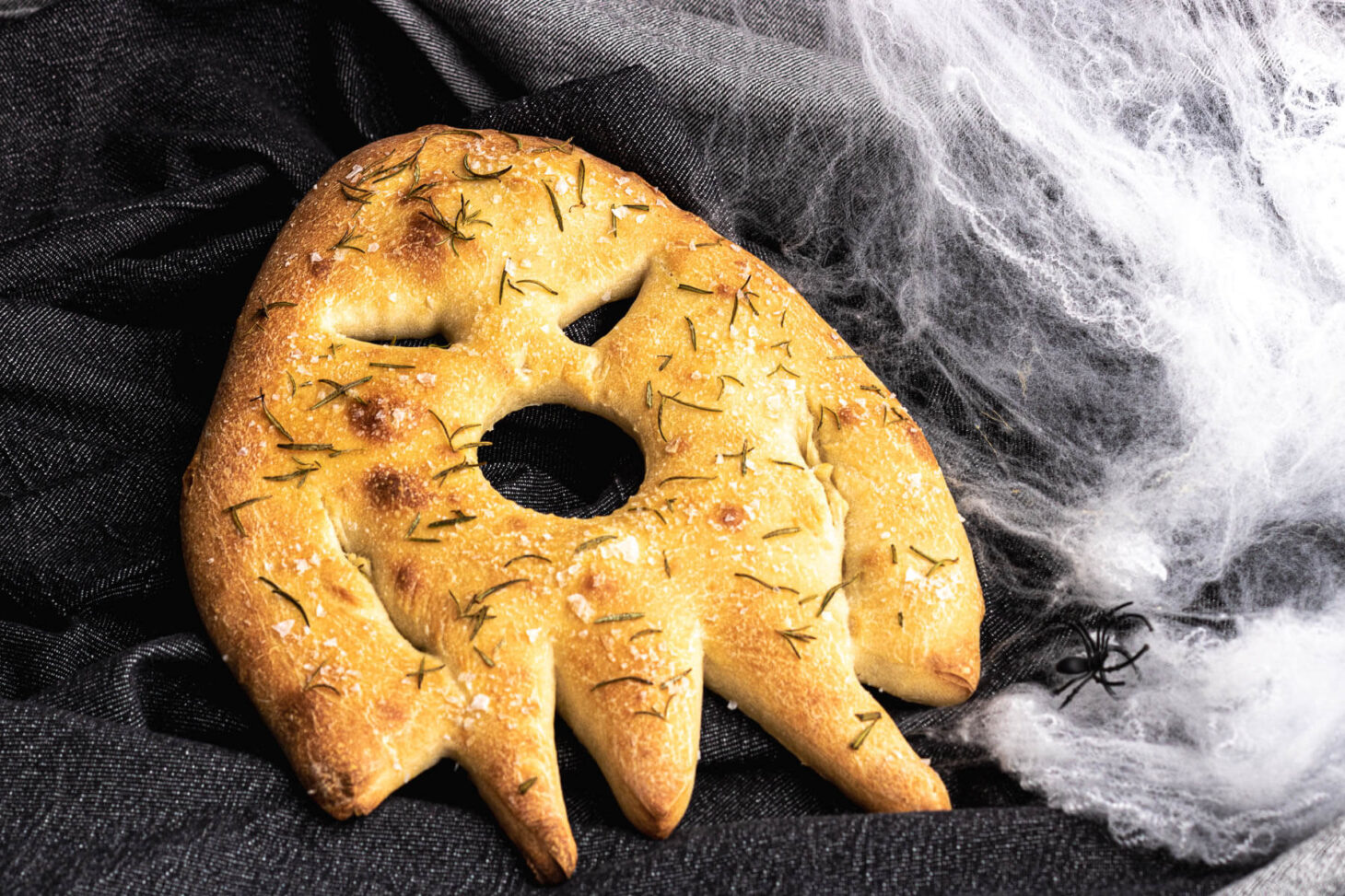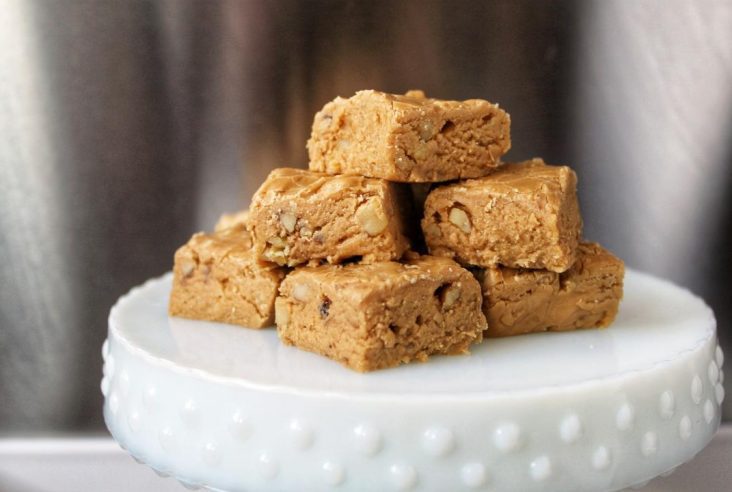Bake up an otherworldly Sourdough Fougasse shaped like a spooky spectre for your Halloween feast. Finish it with rosemary and coarse salt or add your own favourite toppings.
Here at Dish ‘n’ the Kitchen, I have a bit of a bread baking addiction. I like to use my Sourdough Starter to create delicious treats such as Sourdough Plum Cinnamon Rolls and this overnight Sourdough Focaccia Recipe.

Want to save this recipe?
Enter your email below and get this post sent straight to your inbox. Plus, I’ll send you my weekly newsletter featuring the newest and best Dish ‘n’ the Kitchen recipes every week!
Sourdough Fougasse
This Fougasse has it all. A chewy texture, a crispy golden baked crust, and a slightly tangy flavour from the sourdough leavening. There is no commercial yeast in this recipe; only ripe and bubbly sourdough starter.
You can use this recipe to bake up a traditional, leaf shaped French Fougasse or you can let your imagination run away with you like I did. I always thought it would be fun to make a ghostly shape, or Boogasse, if you will.
Hosting a Halloween party or want to make a special Halloween lunch or dinner for your family? This spooky Fougasse makes an excellent Halloween centerpiece and is also great for dipping in hot soup or stew.
This sourdough recipe was adapted slightly from the master of sourdough baking, Maurizio Leo.
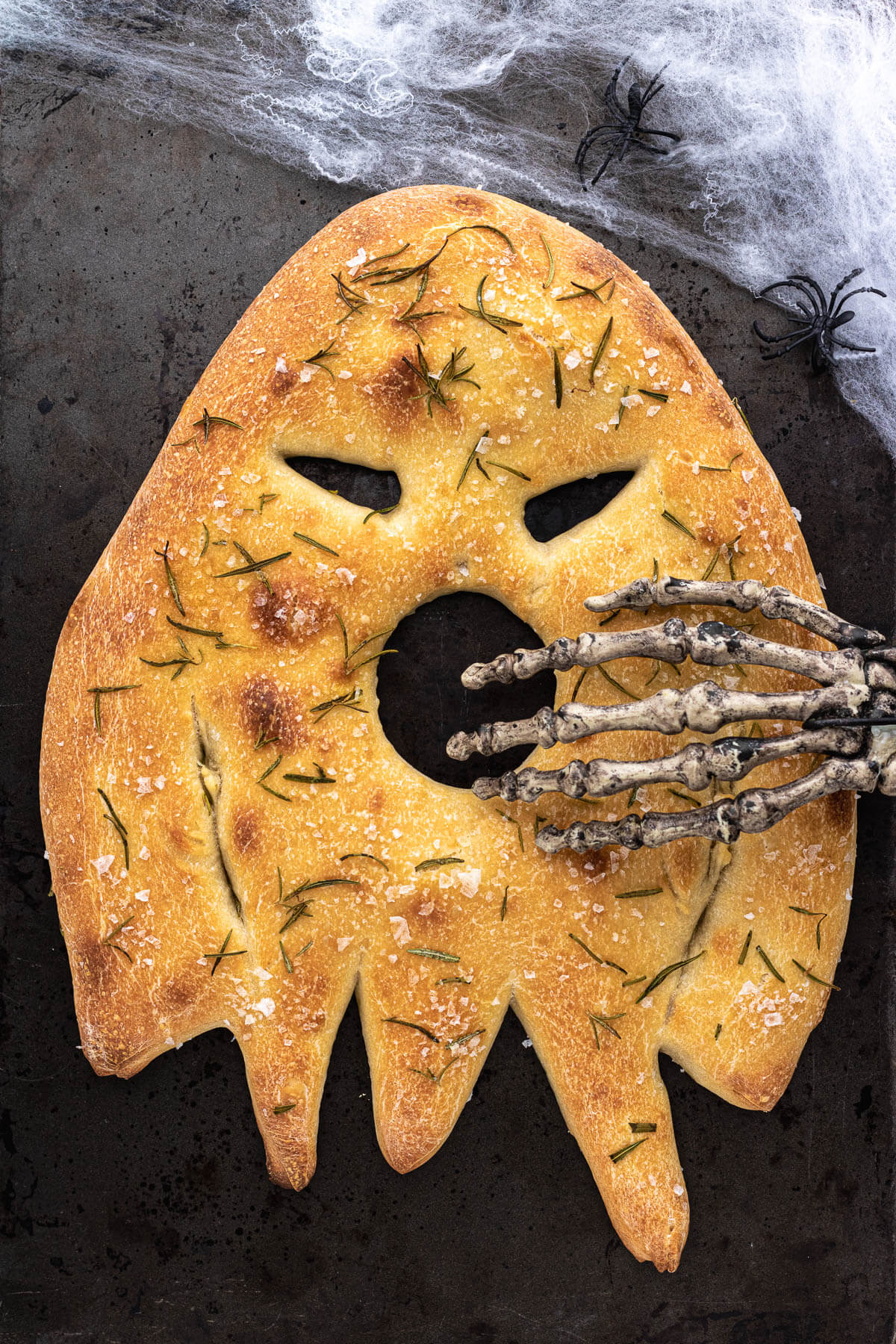
What is Fougasse?
Fougasse (pronounced foo-gaas) is a French flatbread from the Provence region that dates back to Roman times. Traditionally, the bread is rolled flat and shaped, then slashed with a sharp knife in a classic pattern that resembles an ear of wheat or a leaf.
This quick baking bread was originally used to test the hearth (called a focus) or wood fired oven temperature. Every Roman cook knew the baking time of a Fougasse. If it took too long, the fire needed to be stoked. Alternatively, if it burned the flatbread, some wood would be removed.
The original Fougasse would have been leavened with an active sourdough starter and baked using coarse ground flour.
Why Does Fougasse Have Holes?
There are two reasons Fougasse has its characteristic holes. The first is to allow ventilation within the dough, which allow for quick baking. The second reason a Fougasse has holes is to increase the crusty surface area of the bread.
There’s nothing more satisfying that ripping into a fresh flat bread and hearing that characteristic crackle!

Fougasse vs. Focaccia
The most recognizable versions of this style of flatbread are Fougasse and Focaccia. However, even though they contain the same ingredients, there is one important difference between the two.
Focaccia is a softer flatbread which bakes in a well-oiled pan inside an oven. Alternatively, Fougasse is baked on a hearth and is brushed with olive oil, then topped with ingredients such as chopped fresh rosemary or coarse salt. The result is that Fougasse has a crispier exterior than its Italian cousin.
Fougasse is also more likely to contain other ingredients such as olives, peppers, garlic, herbs, or sun dried tomatoes while focaccia dough may or may not contain herbs only. However, I’ve seen focaccia with added ingredients, this is not a hard and fast rule.
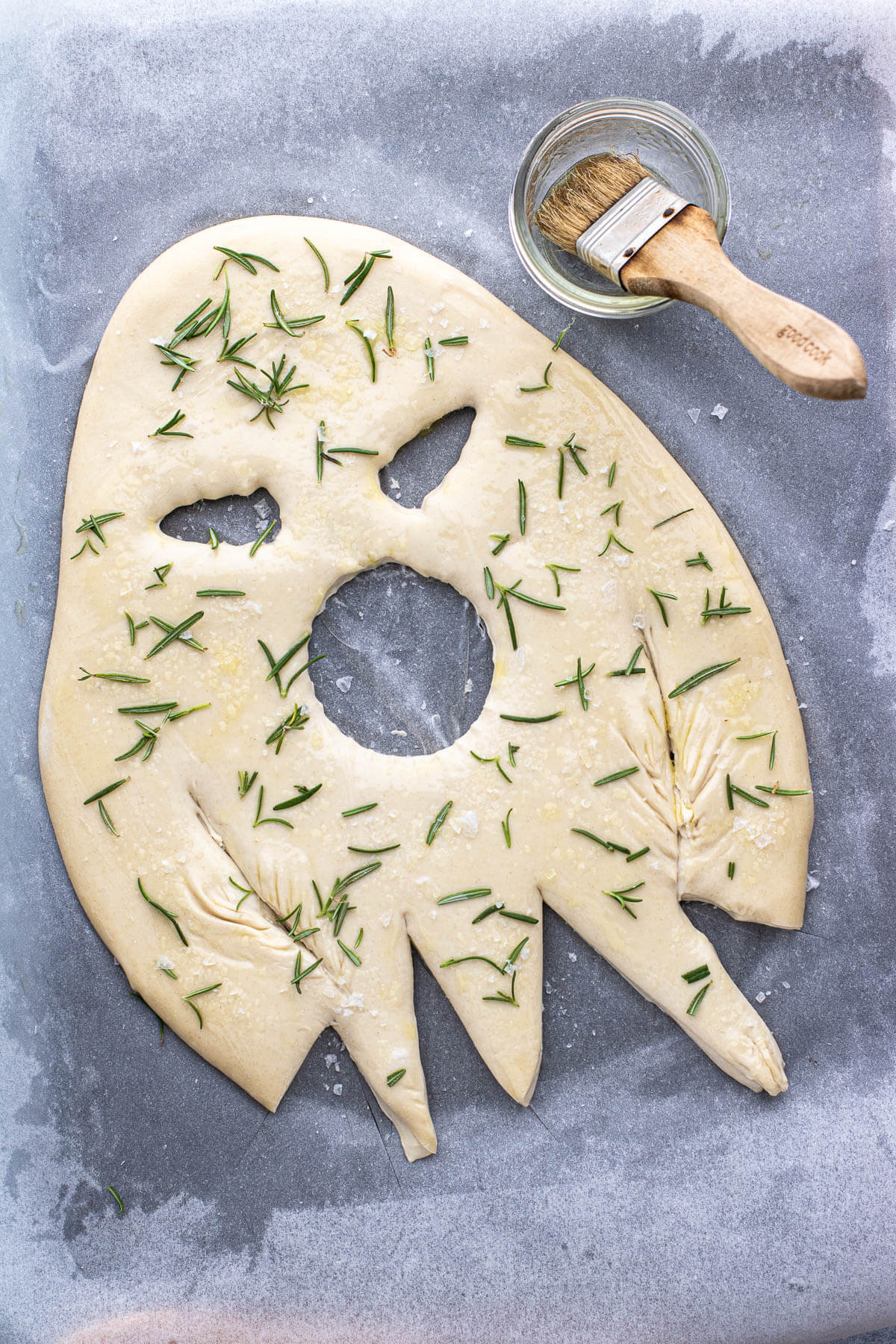
Sourdough Fougasse Ingredients
- Flour
- Salt
- Water
- Sourdough Starter
- Extra Virgin Olive Oil
- Fresh Rosemary
The ingredients in this Fougasse dough are very common to bread baking. Though the original recipe contains All Purpose along with Whole Wheat Flour, my Fougasse recipe contain strong white (non bleached) all purpose flour only.
Strong white flour contains a high amount of protein (or gluten) which is important in allowing the dough to keep its structure while it rises.
Salt plays an important role in dough structure, flavour, and appearance. It encourages the final product to have that desired golden glow. Always use a non iodized natural sea salt when baking sourdough.
In most countries, if the tap water is fine for consumption it is also good for baking. Use bottled water if you tap water is non potable.
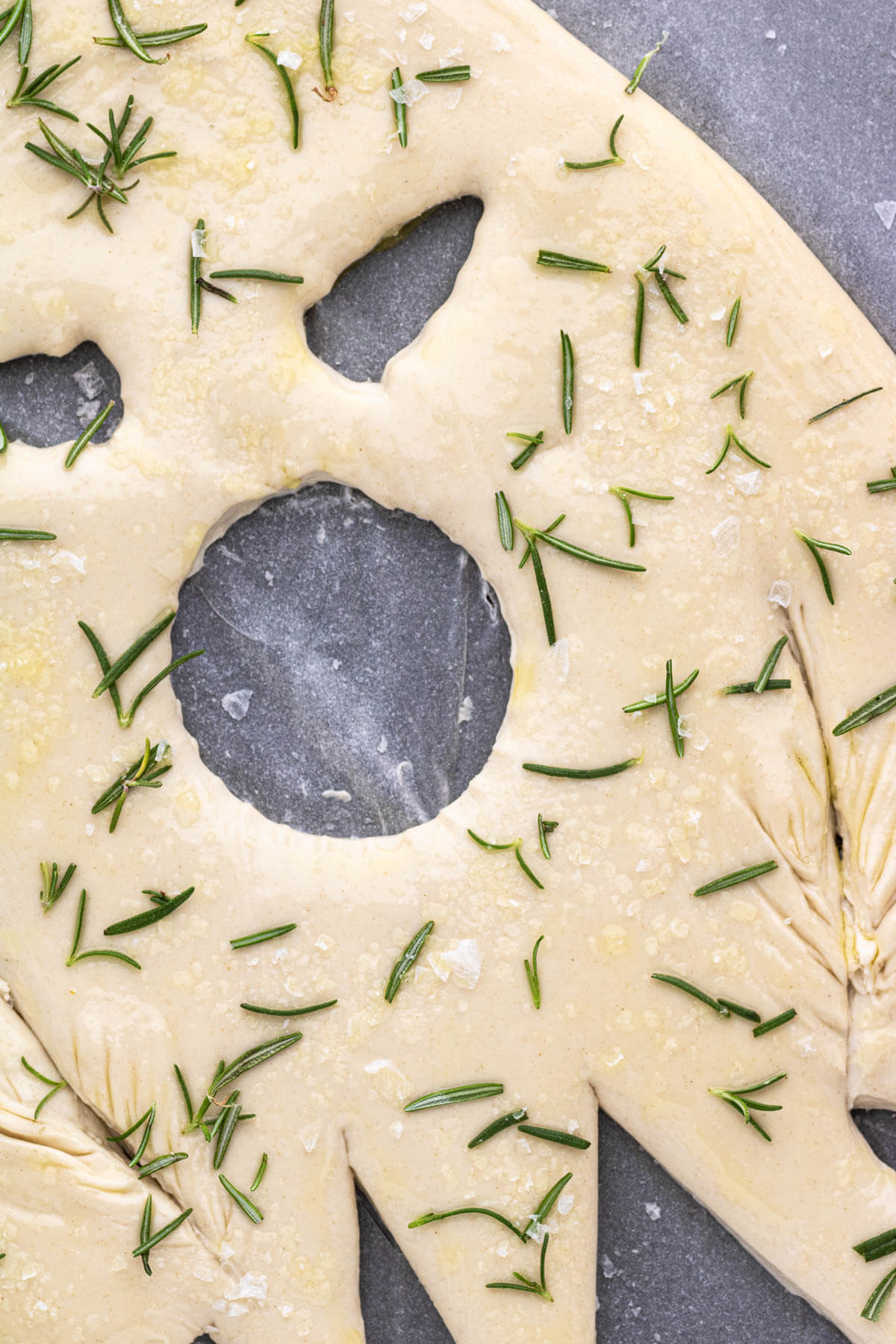
Finally, sourdough starter is the culmination of flour, water and natural yeasts acquired through time. While it’s not really a ‘separate’ ingredient, it is in the recipe in place of commercial yeast. Use an active bubbly starter for this recipe (not sourdough discard).
How to Make Sourdough Fougasse
Please don’t be alarmed at the time it takes to mix, ferment, shape, proof, and bake a sourdough fougasse. In total, the recipe takes just under six hours, but much of that is ‘hands off’ time. All good things come to those who wait!
A. Mix the Dough (10 am)
Place the flour, water, salt, and active starter (levain) in the large bowl of a stand mixer fitted with a dough hook (for hand mixing instructions, refer to the recipe card notes). Mix on low for one minute until ingredients are incorporated, stopping to push them off the hook as needed.
Once ingredients are incorporated, turn the speed up one notch (to 2nd speed) and mix for 1-2 minutes, until the dough begins to ball up around the hook. Do not overmix. Let stand for ten minutes.
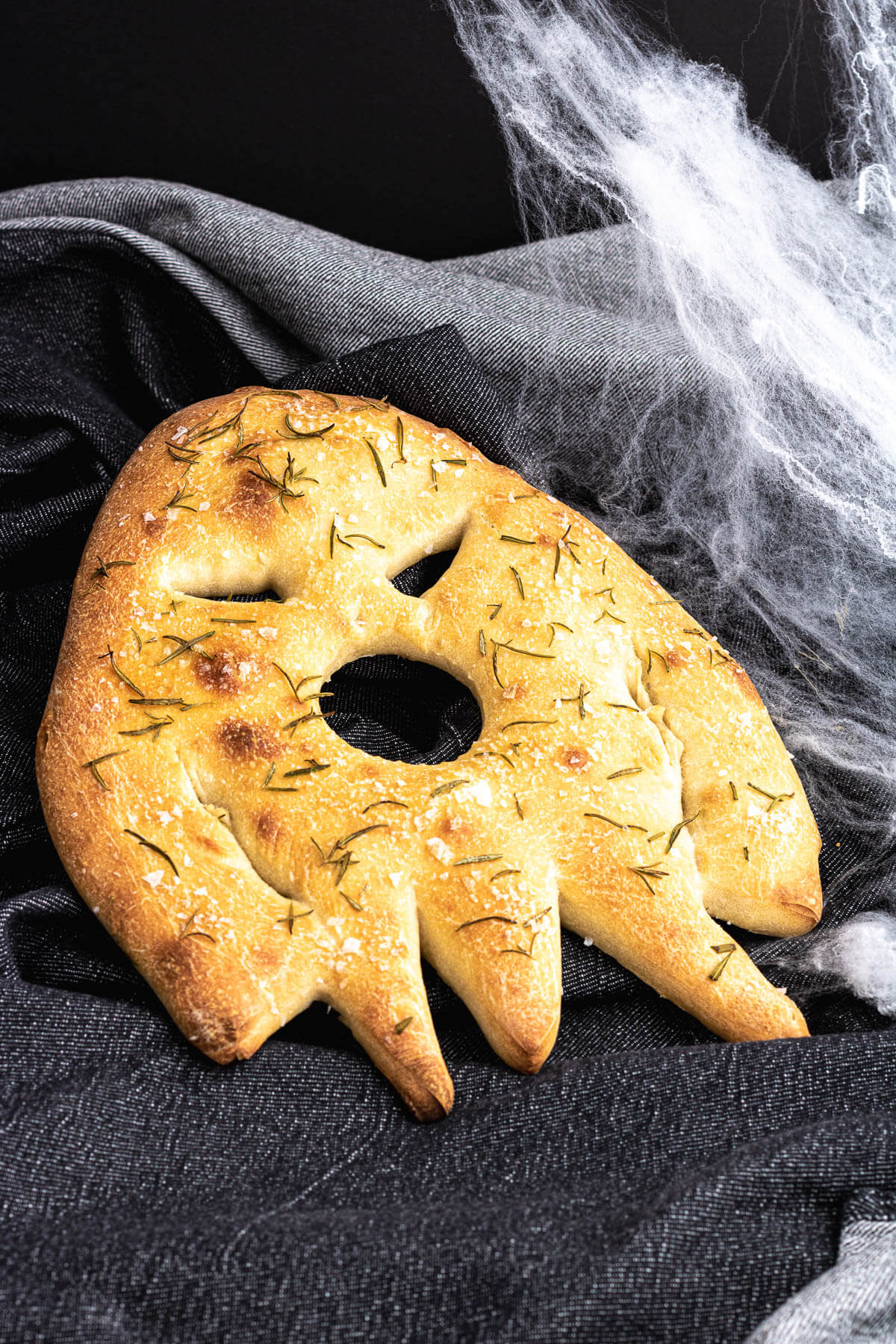
Turn the mixer onto the lowest speed and slowly drizzle oil onto the dough. If the oil isn’t disappearing into the dough, you may have to remove the dough from the hook and press the oil in by hand a few times.
When most of the oil has been incorporated, turn the speed up to 2 and knead for 2-3 minutes more. The dough will begin to soften and relax from the hook. Once it becomes smooth and elastic, remove it from the mixer bowl, place in another bowl, and cover with plastic wrap for fermentation.
Bulk Fermentation with Stretches and Folds (10:30 am – 1:30 pm)
After you have completed mixing the dough, wait 30 minutes, then begin with a series of three stretches and folds, allowing the dough to rest for 30 minutes in between.
Stretch and folds – Grab the edge of the dough opposite to where you are standing. Gently pull upward until you feel slight resistance, then fold it over the dough (towards you). Rotate the bowl and grab the next section that hasn’t been folded. Stretch and fold that section. Repeat four times until each section of the dough has been stretched and folded. Cover and let rest 30 minutes.

Repeat the series of stretches and folds two more times, then cover the dough and allow it to bulk ferment for the remainder of the three hours.
Pre-Shaping (1:30 pm)
Gently release the dough from the fermentation container onto a clean work surface. Tuck the edges of the dough under to create a round ball, then using two hands quickly pull that ball along the surface towards you and release your hands, twisting slightly.
Repeat this motion until the surface of the dough is taught and the dough is in a round ball. Let rest for 30 minutes.
Rolling Out the Dough (2 pm)
Place the dough ball in the centre of a piece of a lightly greased parchment paper the size of a baking sheet. Gently stretch it out into an oblong shape; be sure to avoid disturbing any air bubbles.
Use a rolling pin to gently roll the dough into a larger pear shape, roughly 2/3 of the size of the baking sheet. Use just enough pressure to allow it to spread, but not too much as to deflate the air in the dough. The dough should be about an inch-inch and a half in thickness after rolling.
The Final Proof (2:30 – 4 pm)
Cover the shaped dough with a plastic bag or slightly damp (not wet!) dish towel and let it proof for an hour (check to see if it has doubled in size).
Remove the cover and let the dough proof another 30 minutes; uncovered. This allows the surface of the dough to dry out slightly, making it easier to cut out the eyes and mouth. Preheat the oven to 450 F.
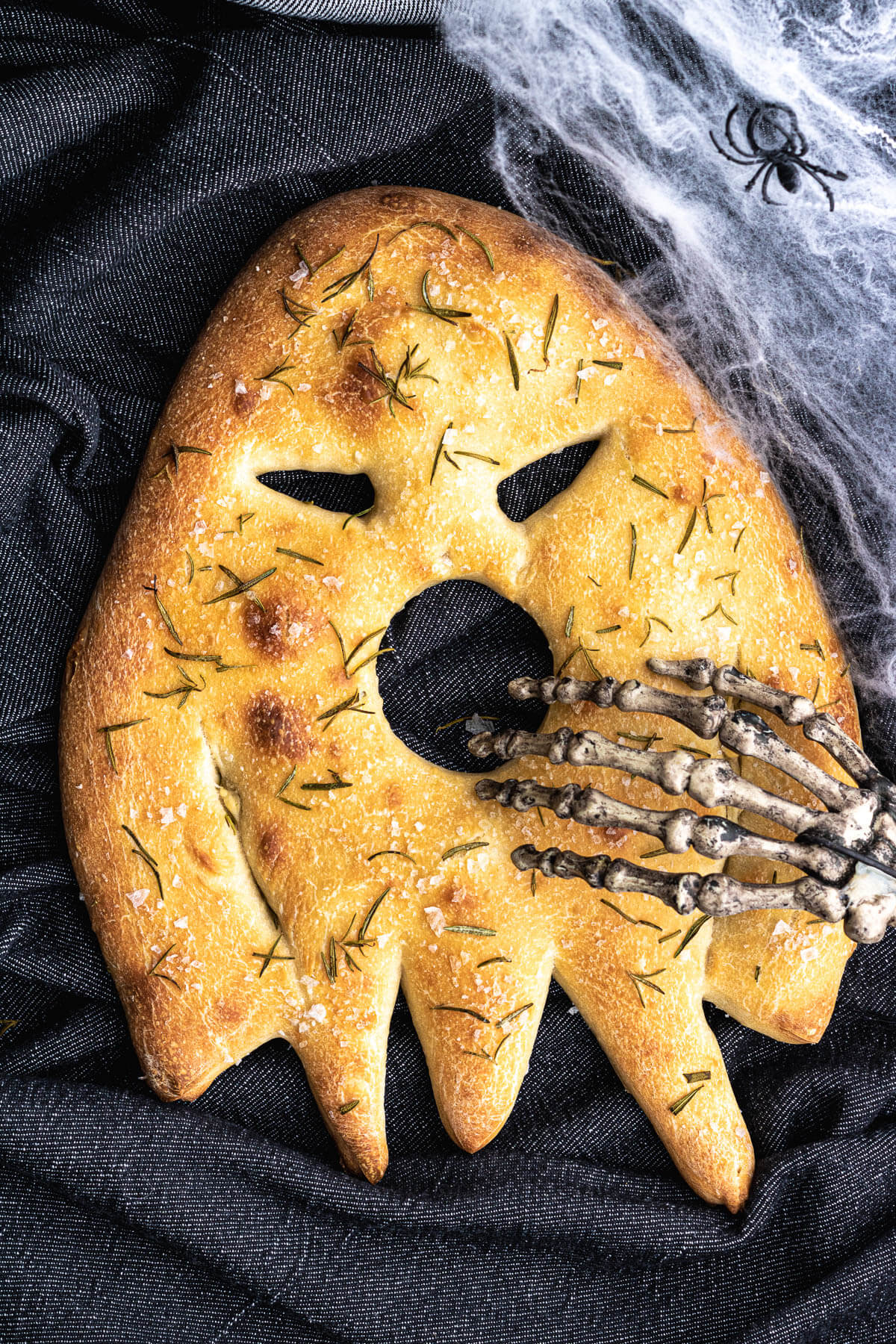
Creating the Halloween Fougasse (4 pm – 4:30)
Use a round cookie cutter to press into the dough and create the mouth. Remove excess dough and discard. Repeat with the eyes using a different shaped cutter or a sharp knife. Pull the dough apart slightly to encourage it to keep the shape.
Use a knife to cut strips from the bottom of the ghost. Pull the remaining edges slightly to elongate them. Discard any excess dough.
Brush the surface of the dough liberally with olive oil and sprinkle coarse salt, chopped fresh rosemary, thyme (or your favourite topping) over the surface of the ghost.
Let’s Bake a Fougasse (4:30 pm)
Grab the edge of the parchment paper and slide it off the work surface straight onto a baking sheet. Bake at 450 F for 20 minutes, then check to see how the crust colour is coming along. Bake for another 5-10 minutes, as needed.
The fougasse is finished baking when you are satisfied with the crust colour and the bottom is golden. The longer the fougasse bakes, the crispier the bread will be.
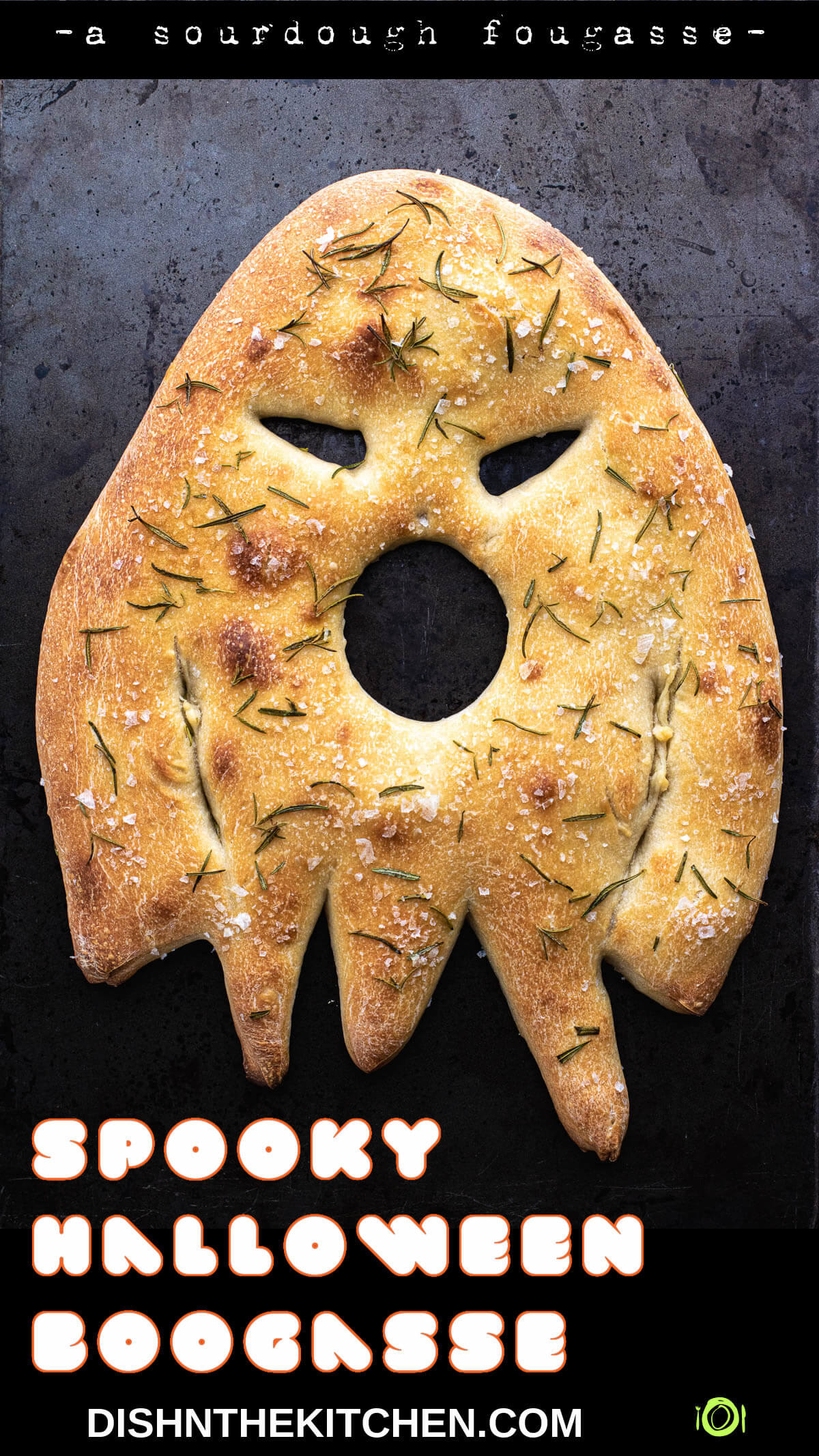
If you make this spooky Halloween Fougasse, please be sure to leave a comment and/or give this recipe a rating! Be sure to follow me on Facebook and Pinterest for my latest recipes. Also, if you do make this recipe, please tag me on Instagram, I’d love to see what you guys are making! Thank you so much for reading my blog.
Sourdough Fougasse (Halloween Boogasse)
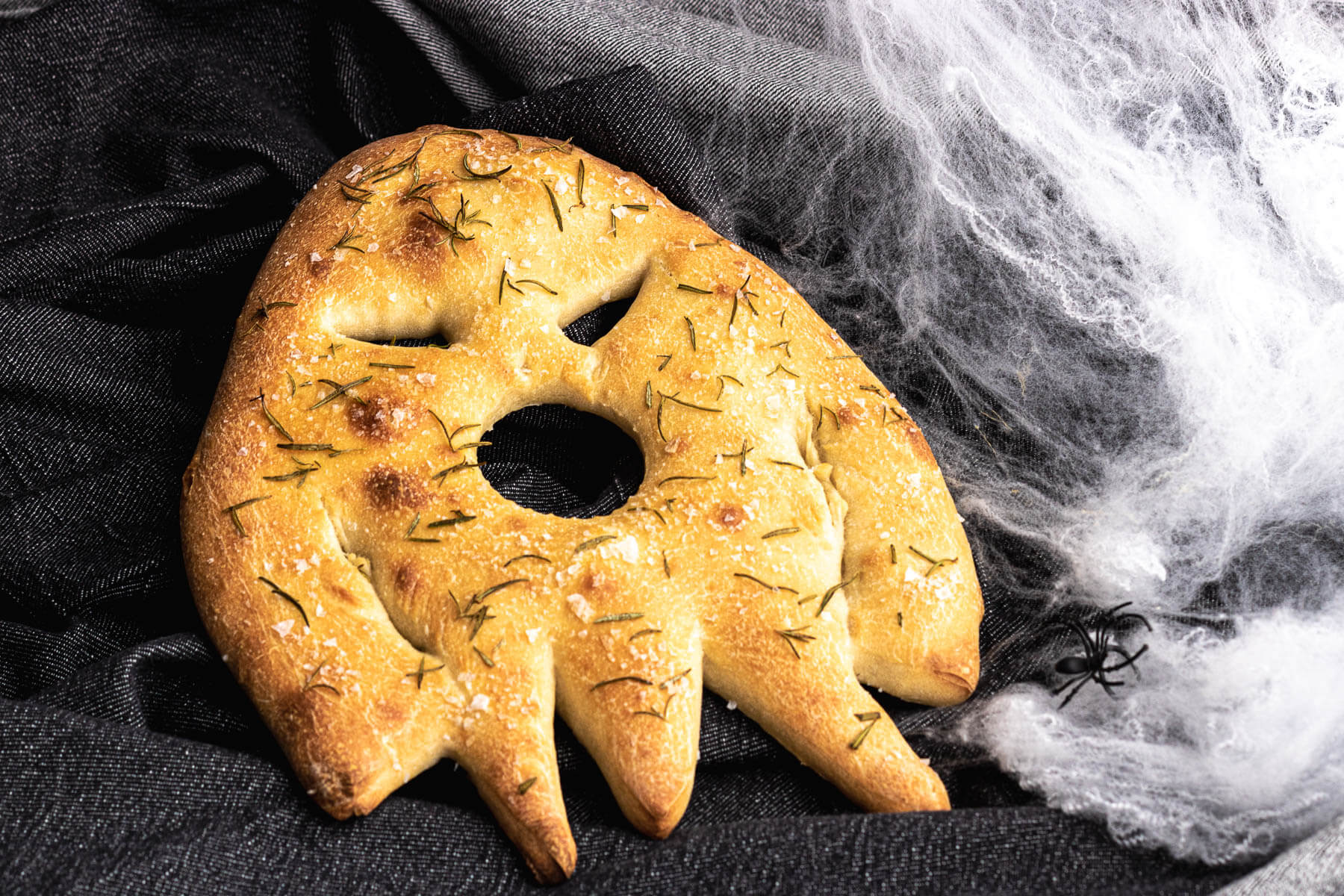
Bake up an otherworldly Sourdough Fougasse shaped like a spooky spectre for your Halloween feast. Finish it with rosemary and coarse salt or add your own favourite toppings.
Ingredients
- 418 grams all purpose flour
- 8 grams kosher or sea salt
- 272 grams water
- 84 grams sourdough starter (active)
- 18 grams olive oil
- A selection of toppings; or simply coarse sea salt and chopped fresh rosemary
Instructions
MIX THE DOUGH (10 am)
- Place flour, water, salt, and active starter (levain) in the bowl of a stand mixer fitted with a dough hook. Mix on low for one minute until ingredients are incorporated, stopping to push them off the hook as needed.
- Once incorporated, turn the speed up one notch (to 2nd speed) and mix for 1-2 minutes, until the dough begins to ball up around the hook. Do not overmix. Let stand for ten minutes.
- Turn the mixer onto the lowest speed and slowly drizzle oil onto the dough. If the oil isn't disappearing into the dough, you may have to remove the dough from the hook and press the oil in by hand a few times.
- When most of the oil has been incorporated, turn the speed up to 2 and knead for 2-3 minutes more. The dough will begin to soften and relax from the hook. Once it becomes smooth and elastic, remove it from the mixer bowl and place in another bowl for fermentation.
BULK FERMENTATION (WITH STRETCHES AND FOLDS) (10:30-1:30 pm)
- After you have completed mixing the dough, wait 30 minutes, then begin with a series of three stretches and folds and allow the dough to rest for 30 minutes in between.
- Stretch and folds - Grab the edge of the dough opposite to where you are standing. Gently pull upward until you feel slight resistance, then fold it over the dough (towards you). Rotate the bowl and grab the next section that hasn't been folded. Stretch and fold that section. Repeat until each section of the dough has been stretched and folded. Cover and let rest 30 minutes.
- Repeat the series of stretches and folds two more times, then cover the dough and allow it to bulk ferment for the remainder of the three hours.
PRESHAPING (1:30 pm)
- Gently release the dough from the fermentation container onto a clean work surface.
- Tuck the edges of the dough under to create a round ball, then using two hands quickly pull that ball along the surface towards you and release, twisting slightly.
- Repeat this motion until the surface of the dough is taught and the dough is in a round ball.
- Let rest for 30 minutes.
ROLLING OUT THE DOUGH (2 pm)
- Place the dough ball in the centre of a piece of a lightly greased parchment paper the size of a baking sheet.
- Gently stretch it out to avoid disturbing any air bubbles.
- Use a rolling pin and gently roll it into a larger pear shape, roughly 2/3 of the size of the baking sheet. Use just enough pressure to allow it to spread, but not too much as to deflate the air in the dough. The dough should be about an inch-inch and a half in thickness.
THE FINAL PROOF (2:30-4:00 pm)
- Cover the shaped dough with a plastic bag or slightly damp (not wet!) dish towel and let it proof for an hour.
- Remove the cover and let the dough proof another 30 minutes; uncovered. This allows the surface of the dough to dry out slightly, making it easier to cut out the eyes and mouth.
- Preheat the oven to 425 F.
CREATING AND TOPPING THE HALLOWEEN FOUGASSE (4 pm)
- Use a round cookie cutter to press into the dough and create the mouth. Remove excess dough and discard. Repeat with the eyes using a different shaped cutter or a sharp knife. Pull the dough apart slightly to encourage it to keep the shape.
- Use a knife to cut strips from the bottom of the ghost. Pull the remaining edges slightly to elongate them. Discard any excess dough.
- Brush the surface of the dough liberally with olive oil, then scatter coarse salt and chopped fresh rosemary over the surface of the ghost. Or, add your favourite toppings.
LET'S BAKE A FOUGASSE (4:30 PM)
- Grab the edge of the parchment paper and slide it and the fougasse onto a baking sheet.
- Bake at 425 F for 20 minutes, then check to see how the crust colour is coming along. Bake for another 5-10 minutes, as needed.
- The fougasse is finished baking when you are satisfied with the crust colour and the bottom is golden. The longer the fougasse bakes, the crispier the bread will be.
Notes
Instructions for hand mixing: Place flour, water, salt, and starter in a large bowl, mix until mostly combined then turn it out to a lightly floured surface. Knead a few times by hand until it is well mixed. Return to the bowl and drizzle in olive oil. Mix by hand until most of the oil is incorporated then turn it out and knead it until it is smooth and elastic.
Nutrition Information:
Yield:
6Serving Size:
1Amount Per Serving: Calories: 305Total Fat: 4gSaturated Fat: 1gTrans Fat: 0gUnsaturated Fat: 3gCholesterol: 0mgSodium: 520mgCarbohydrates: 58gFiber: 2gSugar: 0gProtein: 8g
Nutritional calculation was provided by Nutritionix and is an estimation only. For special diets or medical issues please use your preferred calculator.

